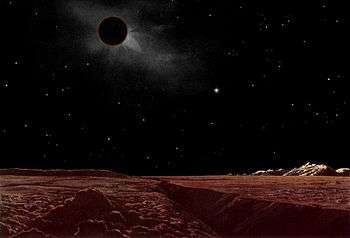Total eclipses on the Moon


Total solar eclipses on the Moon are caused when the Earth passes in front of the Sun, blocking much its light. Viewers on Earth will see a total lunar eclipse.
The last total solar eclipse on the Moon was in July 2018.
Length
Unlike the Earth which sees its eclipse for up to 2 1/2 hours the longest in one area as the Moon's shadow touches for over 5 1/2 hours the longest. Some of the eclipses on the Moon lasts for about 5 hours in one area the longest as the Earth's shadow touches for over 6 hours the longest.
Some eclipses are longer when the Earth is slightly closer (on Earth, the Moon is seen with its apparent diameter is larger than the sun's), some eclipses are shorter when the Earth is slightly further (on Earth, the Moon is seen with its apparent diameter is smaller than the sun's).
Center of the Earth's shadow
Unlike the Earth which receives the smallest portion being inside the center of the moon's shadow during total solar eclipses. During its total eclipses on the Moon, the center of the Earth's shadow covers the whole Nearside part of the Moon and lasts much longer than on Earth with up to around 2.8 hours.[3] Some total-partial eclipses have a most, half or a part of the Moon being in the center of the Earth's shadow.
Unlike the Earth which it umbral shadow shows black, as the Moon has no atmosphere, the surface appears red because the only sunlight available is refracted through the Earth's atmosphere on the edges of the earth as it is shown in the sky in a painting by Lucien Rudaux.[1]
See also
- Solar eclipses on the Moon
- List of central lunar eclipses - On Earth, they are seen as central total lunar eclipses
- Total eclipse - Total eclipses that are seen on Earth that its light are blocked by the Moon for a couple of minutes
References
- 1 2 The moon's surface appears red because the only sunlight available is refracted through the Earth's atmosphere on the edges of the earth, as shown in the sky in this painting.
- ↑ The Earth will be in new phase, completely dark, except for moonshine and sunlight refracted through the earth's atmosphere, visible as a ring of light.
- ↑ Lunar eclipses